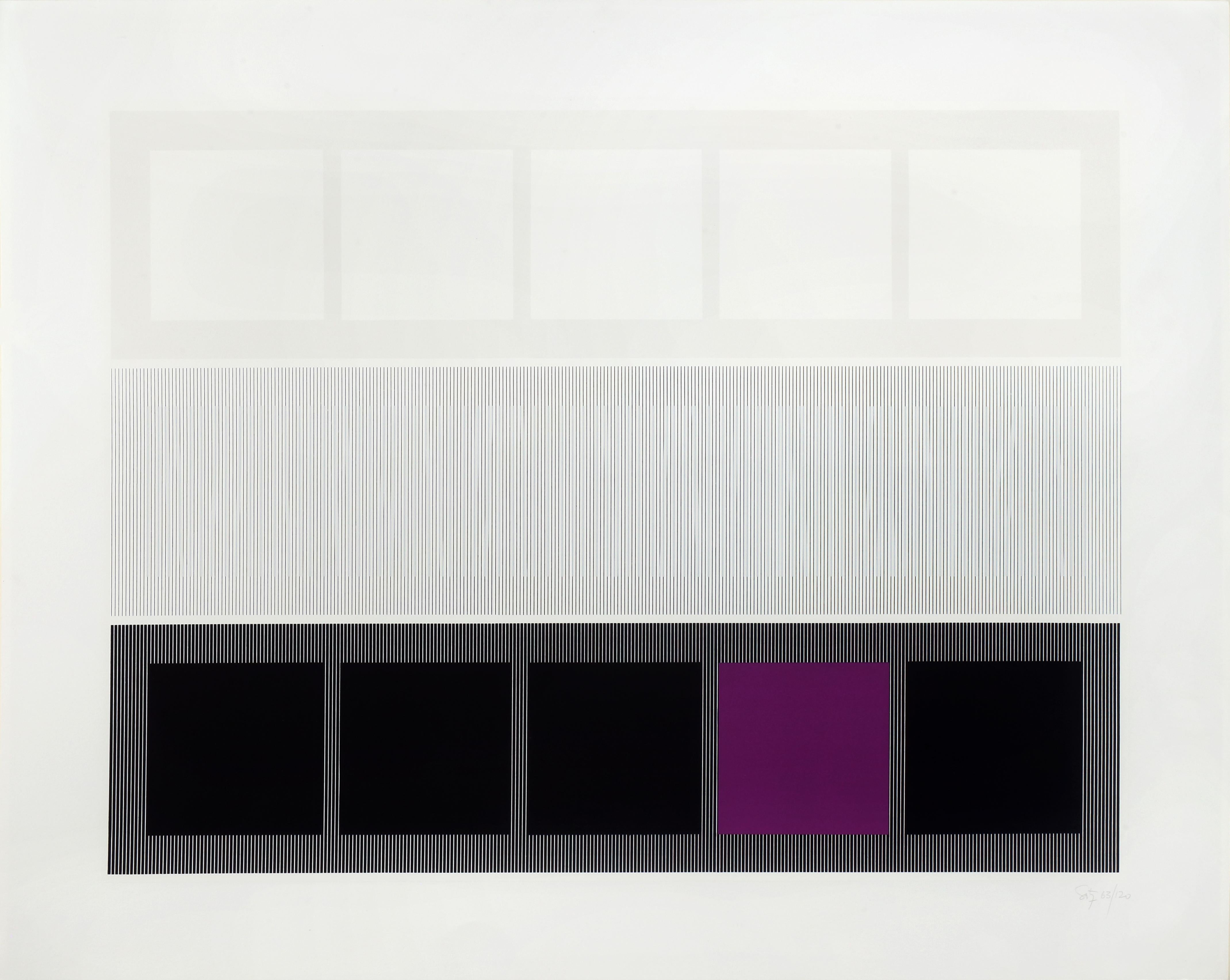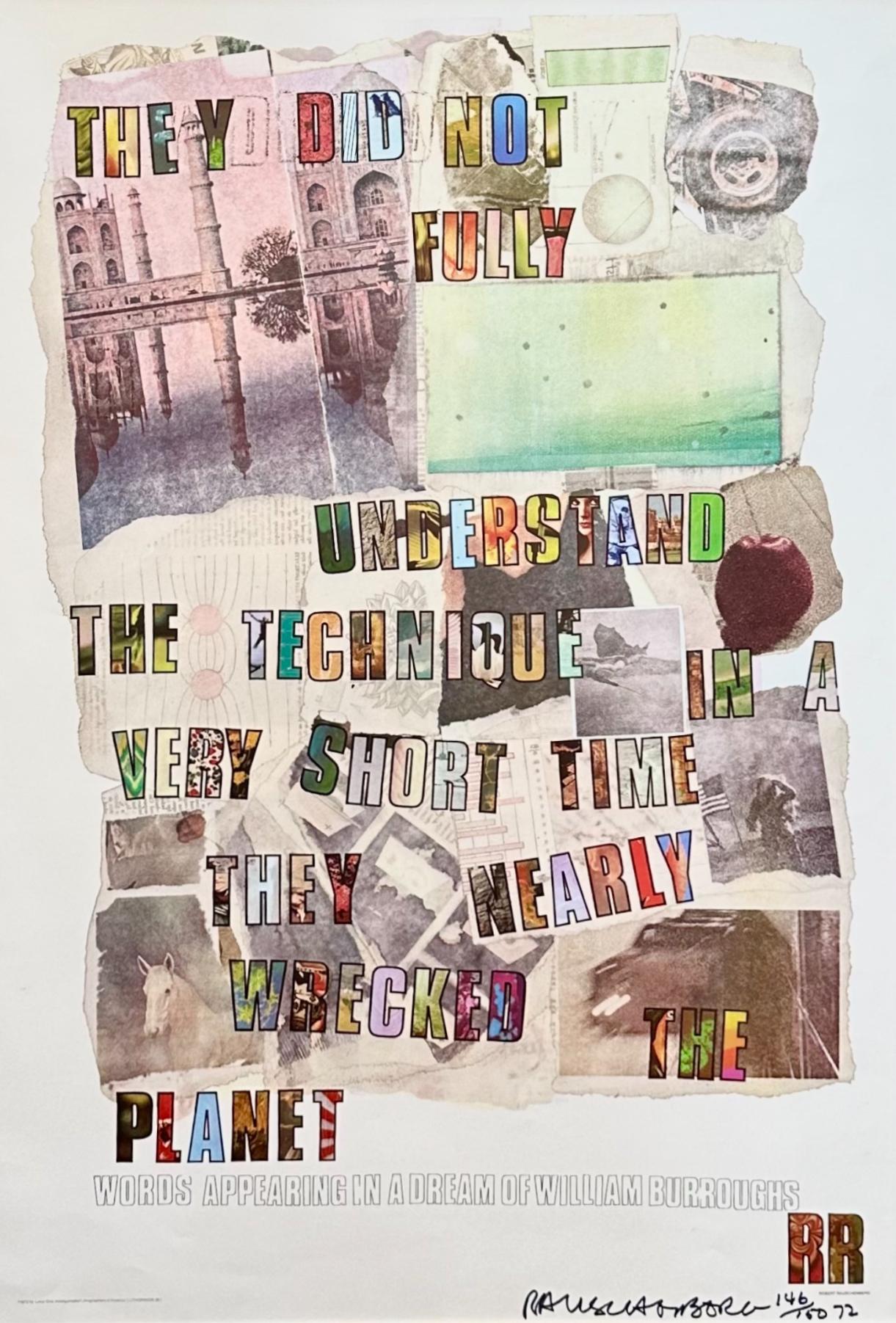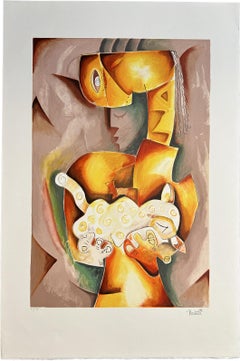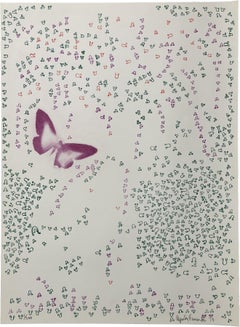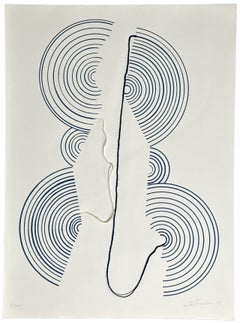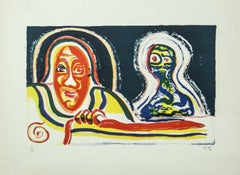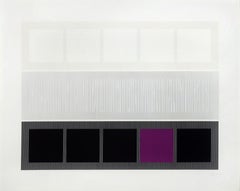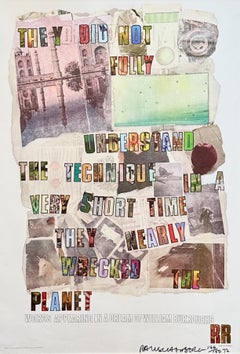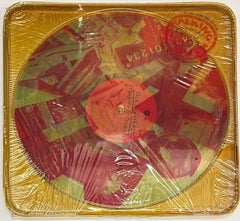Items Similar to Royal Curtain 1980 Signed Limited Edition Lithograph
Want more images or videos?
Request additional images or videos from the seller
1 of 8
Gene DavisRoyal Curtain 1980 Signed Limited Edition Lithograph1980
1980
About the Item
Gene Davis
Royal Curtain - 1980
Print - Silkscreen, on Arches archival paper 30'' x 22'' inches
Edition: signed in pencil and marked 180/250
Unframed
Known for his dazzling and immediately recognizable stripe paintings, Gene Davis emerged from the ranks of the Washington Color School to national prominence. Davis, who helped make Washington, D.C., a center of contemporary art, played a significant national and international role in the color abstraction movement.
Encouraged and championed by Jacob Kainen and later by Clement Greenberg, Davis enjoyed scores of major exhibitions during his long career.
- Creator:Gene Davis (1920-1985, American)
- Creation Year:1980
- Dimensions:Height: 30 in (76.2 cm)Width: 22 in (55.88 cm)Depth: 1 in (2.54 cm)
- Medium:
- Period:
- Condition:
- Gallery Location:Rochester Hills, MI
- Reference Number:1stDibs: LU2335214065262
Gene Davis
Davis was born in Washington D.C. in 1920 and spent nearly all his life there. Before he began to paint in 1949, he worked as a sportswriter, covering the Washington Football Team and other local teams. Working as a journalist in the late 1940s, he covered the Roosevelt and Truman presidential administrations, and was often President Truman's partner for poker games. His first art studio was in his apartment on Scott Circle; later he worked out of a studio on Pennsylvania Avenue. Davis's first solo exhibition of drawings was at the Dupont Theater Gallery in 1952, and his first exhibition of paintings was at Catholic University in 1953. A decade later he participated in the "Washington Color Painters" exhibit at the Washington Gallery of Modern Art in Washington, DC, which traveled to other venues around the US, and launched the recognition of the Washington Color School as a regional movement in which Davis was a central figure. The Washington painters were among the most prominent of the mid-century color field painters. Though, he worked in a variety of media and styles, including ink, oil, acrylic, video, and collage, Davis is best known by far for his acrylic paintings (mostly on canvas) of colorful vertical stripes, which he began to paint in 1958. The paintings typically repeat particular colors to create a sense of rhythm and repetition with variations. One of the best-known of his paintings, "Black Grey Beat" (1964), owned by the Smithsonian American Art Museum reinforces these musical comparisons in its title. The pairs of alternating black and grey stripes are repeated across the canvas, and recognizable even as other colors are substituted for black and grey, and returned to even as the repetition of dark and light pairs is here and there broken by sharply contrasting colors. In 1972 Davis created Franklin's Footpath, which was at the time the world's largest artwork, by painting colorful stripes on the street in front of the Philadelphia Museum of Art, and the world's largest painting, Niagara (43,680 square feet), in a parking lot in Lewiston, NY. His "micro-paintings", at the other extreme, were as small as 3/8 of an inch square. For a public work in a different medium altogether, he designed the color patterns of the "Solar Wall," a set of tubes filled with dyed water and backlit by fluorescent lights, at the Muscarelle Museum of Art at the College of William and Mary in Williamsburg, Virginia. Davis began teaching in 1966 at the Corcoran School of Art, where he became a permanent member of the faculty. His works are in the collections of, among others, the Corcoran Gallery of Art, the Solomon R. Guggenheim Museum, The Phillips Collection in Washington, DC, the Walker Art Center in Minneapolis, MN, The Governor Nelson A. Rockefeller Empire State Plaza Art Collection in Albany, NY, and the Smithsonian American Art Museum. He died on April 6, 1985 in Washington, DC.
About the Seller
4.8
Platinum Seller
Premium sellers with a 4.7+ rating and 24-hour response times
Established in 2000
1stDibs seller since 2023
72 sales on 1stDibs
Typical response time: <1 hour
- ShippingRetrieving quote...Shipping from: Rochester Hills, MI
- Return Policy
Authenticity Guarantee
In the unlikely event there’s an issue with an item’s authenticity, contact us within 1 year for a full refund. DetailsMoney-Back Guarantee
If your item is not as described, is damaged in transit, or does not arrive, contact us within 7 days for a full refund. Details24-Hour Cancellation
You have a 24-hour grace period in which to reconsider your purchase, with no questions asked.Vetted Professional Sellers
Our world-class sellers must adhere to strict standards for service and quality, maintaining the integrity of our listings.Price-Match Guarantee
If you find that a seller listed the same item for a lower price elsewhere, we’ll match it.Trusted Global Delivery
Our best-in-class carrier network provides specialized shipping options worldwide, including custom delivery.More From This Seller
View AllMy Journey Portfolio 1998 Mourlot Lithographs Healing Efforts and Big Hearts
By Alexandra Nechita
Located in Rochester Hills, MI
Artist: Alexandra Nechita
Title: My Journey - Blue Portfolio
Artworks: Healing Efforts, Big Hearts Are Never Too Big
Year: 1998
Lithographs on Arches Archival Paper
Size; 35½'' x...
Category
1990s Abstract Figurative Prints
Materials
Lithograph
Alexandra Nechita 1998 Soft Velvet Cat Signed Limited Edition Lithograph
By Alexandra Nechita
Located in Rochester Hills, MI
Artist: Alexandra Nechita
Title: Soft Velvet Cat
Year: 1998
Lithograph on Arches Archival Paper
Size; 35½'' x 23½'' inches
Edition: Signed in pencil, dated and marked 65/199
Embo...
Category
1990s Abstract Figurative Prints
Materials
Lithograph
Butterfly Construction 1979 Signed Limited Edition Lithograph
By Agustín Fernández
Located in Rochester Hills, MI
Agustin Fernandez
Construction - 1979
Print - Lithograph on Arches archival paper
Paper size 21.75'' x 29.5'' inches
Edition: Signed in pencil, dated and marked 1/300
Agustín Fernán...
Category
1970s Abstract Abstract Prints
Materials
Lithograph
Midnight Blue 1979 Signed Limited Edition Lithograph
By Agustín Fernández
Located in Rochester Hills, MI
Agustin Fernandez
Midnight Blue - 1979
Print - Yarn, Lithograph on Arches archival paper
Paper size 21.75'' x 29.5'' inches
Edition: Signed in pencil, dated and marked 8/300
Agustín...
Category
1970s Abstract Abstract Prints
Materials
Lithograph
Louisiana Serenade 1979 Signed Limited Edition Lithograph
By Romare Bearden
Located in Rochester Hills, MI
Romare Bearden
Louisiana Serenade (from Jazz Series) - 1979
Print - Lithograph
Framed - 33 x 42 inches
Edition: Signed in pencil and marked 159/175
Romare Bearden is among the pree...
Category
1970s Abstract Abstract Prints
Materials
Lithograph
Blue Mask 1971 Signed Limited Edition Lithograph
By Karel Appel
Located in Rochester Hills, MI
Karel Appel
Blue Mask
1971
Lithograph - 43" x 29" inches
Edition: signed in pencil and marked 1/100
Description
Karel Appel is one of the founding members of the CoBrA movement in ...
Category
1970s Abstract Expressionist Abstract Prints
Materials
Lithograph
$6,000 Sale Price
20% Off
You May Also Like
Marcel Pouget original signed limited ed. lithograph
Located in Paonia, CO
Marcel Pouget (1923 -1985 ) painter, poet, choreographer and film maker was a member of the avant -garde group COBRA. This was a reactionary movement in search of free expre...
Category
Mid-20th Century Abstract Expressionist Abstract Prints
Materials
Lithograph
Untitled
By Jesús Rafael Soto
Located in Miami, FL
Jesus Rafael Soto
“Untitled”
Lithograph Ed. 63 of 120
29 x 23 in
Category
20th Century Kinetic Abstract Prints
Materials
Lithograph
The Dream of William Burroughs
By Robert Rauschenberg
Located in Naples, Florida
This is an Offset Lithograph in colors and was produced in 1972. The lithograph is hand signed by the artist, dated 72, and numbered 146/150 at lower right. It was dedicated in the j...
Category
Late 20th Century Abstract Abstract Prints
Materials
Paper, Lithograph
Robert Rauschenberg Talking Heads Speaking in Tongues (new/sealed)
By Robert Rauschenberg
Located in NEW YORK, NY
Rare unopened Robert Rauschenberg designed Talking Heads Speaking in Tongues:
In 1983, legendary pop artist Robert Rauschenberg designed the album cover for Talking Heads’ acclaimed...
Category
1980s Pop Art Mixed Media
Materials
Lithograph, Offset
Composition C n°III in Red, Blue and Yellow - Lithograph
By Piet Mondrian
Located in Paris, IDF
Piet MONDRIAN (after)
Composition II in Red, Blue and Yellow
Lithograph (8 colors)
Printed signature in the plate
Justified HC (Hors commerce)
Blind stamp of the editor in the marg...
Category
21st Century and Contemporary Abstract Geometric Abstract Prints
Materials
Lithograph
German Surrealism Abstract Surrealist Lithograph Hans Bellmer
By Hans Bellmer
Located in Surfside, FL
Hans Bellmer German (1902–1975)
Abstract Surrealist Lithograph
Souterrain No. 13 8 1944 Musée Jean Brun
Date: circa 1965
Hand signed and numbered in pencil Edition of 100
Size: 19.5 x 26.5 in.
Hans Bellmer ( 1902 – 1975) was a Polish born German artist, best known for his drawings, etchings that illustrates the 1940 edition of Histoire de l’œil, and the life-sized female sculpture mannequin dolls he produced in the mid-1930s. Historians of art and photography also consider him a Surrealist photographer.
Bellmer was born in the city of Kattowitz, then part of the German Empire (now Katowice, Poland). Up until 1926, he worked as a draftsman for his own advertising company.
Bellmer is most famous for the creation of a series of dolls as well as photographs of them. He was influenced in his choice of art form in part by reading the published letters of Oskar Kokoschka (Der Fetisch, 1925) and Surrealism. Bellmer's puppet doll project is also said to have been catalysed by a series of events in his personal life.
Hans Bellmer takes credit for provoking a physical crisis in his father and brings his own artistic creativity into association with childhood insubordination and resentment toward a severe and humorless paternal authority. Perhaps this is one reason for the nearly universal, unquestioning acceptance in the literature of Bellmer's promotion of his art as a struggle against his father, the police, and ultimately, fascism and the state. Events of his personal life also including meeting a beautiful teenage cousin in 1932 (and perhaps other unattainable beauties), attending a performance of Jacques Offenbach's Tales of Hoffmann (in which a man falls tragically in love with an automaton), and receiving a box of his old toys. After these events, he began to actually construct his first dolls. In his works, Bellmer explicitly sexualized the doll as a young girl (his work bears connection to the works of Bathus). Hirschfeld has claimed (without further argumentation) that Bellmer initiated his doll project to oppose the fascism of the Nazi Party by declaring that he would make no work that would support the new German state. Represented by mutated forms and unconventional poses, his dolls (according to this view) were directed specifically at the cult of the perfect body then prominent in Germany.
He visited Paris in 1935 and made contacts there, such as Paul Éluard, but returned to Berlin because his wife Margarete was dying of tuberculosis. He was part of the circle of Surrealist luminaries such as Man Ray, Marcel Duchamp, Max Ernst, Joan Miro, André Masson, René Magritte, Alberto Giacometti and Salvador Dali as well as women artists—such as Frida Kahlo, Dorothea Tanning and Leonora Carrington.
Bellmer produced the first doll in Berlin in 1933. Long since lost, the assemblage can nevertheless be correctly described thanks to approximately two dozen photographs Bellmer took at the time of its construction. Standing about fifty-six inches tall, the doll consisted of a modeled torso made of flax fiber, glue, and plaster; a mask-like head of the same material with glass eyes and a long, unkempt wig; and a pair of legs made from broomsticks or dowel rods. One of these legs terminated in a wooden, club-like foot; the other was encased in a more naturalistic plaster shell, jointed at the knee and ankle. As the project progressed, Bellmer made a second set of hollow plaster legs, with wooden ball joints for the doll's hips and knees. There were no arms to the first sculpture, but Bellmer did fashion or find a single wooden hand, which appears among the assortment of doll parts the artist documented in an untitled photograph of 1934, as well as in several photographs of later work.
Bellmer's 1934 anonymous book, The Doll (Die Puppe), produced and published privately in Germany, contains 10 black-and-white photographs of Bellmer's first doll arranged in a series of "tableaux vivants" (living pictures). The book was not credited to him, as he worked in isolation, and his photographs remained almost unknown in Germany. Yet Bellmer's work was eventually declared "degenerate" (entartete kunst) by the Nazi Party, and he was forced to flee Germany to France in 1938, where Bellmer's work was welcomed by the Surrealists around Andre Breton.
He aided the French Resistance during the war by making fake passports. He was imprisoned in the Camp des Milles prison at Aix-en-Provence, a brickworks camp for German nationals, from September 1939 until the end of the Phoney War in May 1940.
After the war, Bellmer lived the rest of his life in Paris. Bellmer gave up doll-making and spent the following decades creating erotic drawings, etchings, sexually explicit photographs, paintings, and prints of pubescent girls. In 1954, he met Unica Zürn, who became his companion until her suicide in 1970. He continued working into the 1960s
Cécile Reims (1927) has been drawing the world that surrounds her since her childhood in Lithuania, and subsequently in Paris, Jerusalem, and Barcelona. As a Jew, she had to go into hiding during World War II, and found herself at death’s door when she contracted tubercu- losis. Recovering from the disease, she felt she had to give meaning to her life as a survivor and she experienced a “conversion to art” as one is converted to a religion. Her encounter with the engraver Joseph Hecht in 1945 introduced her to the burin, an unforgiving tool which became her medium of choice. In her early years as an artist, she produced the mysterious Visages d’Espagne, Metamorphoses and Bestiaire de la mort series. But in order to support her work as an artist and to help Fred Deux (1924), whom she married in 1952, she suddenly gave a new twist to her career by turning to the interpretation of others’ work and engraving the drawings made by other artists. Cécile Reims filled this role with good humour and immense talent, as well as secretly collaborating with numerous artists working in the surrealist mode, such as Hans Bellmer, from 1966 to 1975, Salvador Dalí, from 1969 to 1988, Fred Deux, from 1970 to 2008, and Leonor Fini, from 1972 to 1995.
In 2004, the Bibiothèque Nationale de France held an important retrospective devoted to Cécile Reims, suddenly putting into the limelight a figure who had long been kept in the shadows. At that point it became essential to produce a catalogue raisonné of her miniature engravings...
Category
20th Century Abstract Abstract Prints
Materials
Lithograph
Recently Viewed
View AllMore Ways To Browse
Arsham Bronze
Astro Boy Vintage
Aubrey Beardsley Salome
Audean Johnson
Aztec Sculpture Mosaic
Bagni Di Lucca
Balloon Dog Plate Blue
Balthazar Korab
Banksy Di Faced
Banksy Flower Thrower
Banksy Sale Ends
Banksy Tesco
Barbara Lekberg Sculpture
Barnegat Light
Baston Vintage
Bear Sahara Novotny
Bearbrick Van Gogh
Bearden Bopping At Birdland

